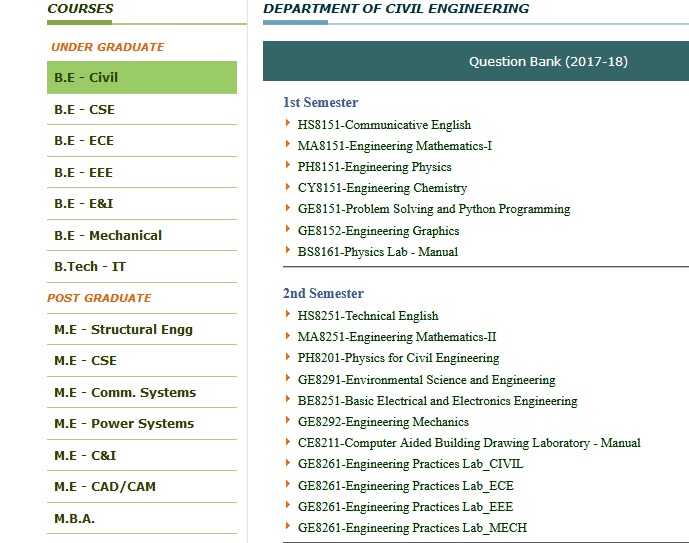CE6301 Engineering Geology Question Bank : valliammai.co.in
Name of the College : Valliammai Engineering College
Subject : Engineering Geology
Website : valliammai.co.in
Document Type : Question Bank
Download Model/Sample Question Paper :
QUESTION BANK : https://www.pdfquestion.in/uploads/valliammai.co.in/405-ENGINEERING%20GEOLOGY.pdf
Valliammai Engineering Geology Question Bank
Physical Geology :
Related : Valliammai Engineering College CE6306 Strength of Materials B.E Question Bank : www.pdfquestion.in/1744.html
Unit I
Geology in civil engineering – branches of geology – structure of earth and its composition – weathering of rocks – scale of weathering – soils – landforms and processes associated with river, wind, groundwater and sea – relevance to civil engineering. Plate tectonics – Earth quakes – Seismic zones in India.
Part – A
1. Define engineering geology.
2. Describe briefly the layers of interior of earth.
3. Define weathering.
4. What is meant by seismic zone?
5. What is physical weathering?
6. What is chemical weathering?
7. What is spheroidal weathering?
8. Define mohorovicic and Guttenburg discontinuity.
9. Define plate tectonics.
10. Define exfoliation.

11. Differentiate between water table and perched water table.
12. Define aquifer and mention its types.
13. What is meant by subduction zone? Mention its importance.
14. Differentiate aquifer and aquiclude.
15. Write about Mercalli scale.
16. Describe the interior of the earth.
17. Define confined aquifer.
18. Define unconfined aquifer.
19. Mention the seismic zones of India.
Part – B
1. Write in detail about the structure of the earth and its composition with a neat diagram.
2. Give an account on mode of occurrence and prospecting of ground water.
3. Describe in detail about plate tectonics.
4. Explain in detail about weathering of rocks and its engineering importance.
5. Explain in detail about the earthquake belts of India.
6. Write in detail about the scope of geology and importance of geology in Civil Engineering.
7. Explain physical and chemical weathering process in detail. Add a note on weathering grade and its engineering significance.
8. Explain the process associated with river. Write their engineering significance.
9. Explain the process associated with winds. Write their engineering significance.
10. Explain the process associated with sea. Write their engineering significance.
Unit II
MINEROLOGY
Physical properties of minerals – Quartz group, Feldspar group, Pyroxene – hypersthene and augite, Amphibole – hornblende, Mica – muscovite and biotite, Calcite, Gypsum and Clay minerals.
Part – A
1. Define mineralogy.
2. Define hexagonal, isometric, tetragonal, orthorhombic, triclinic, monoclinic system of crystals.
3. Write the physical properties of mica.
4. Define mineral.
5. What are the different physical properties of minerals?
6. Give the physical properties and uses of quartz, augite.
7. What is moh’s scale of hardness?
8. Give the physical properties and uses of hornblende, biotite.
9. Name at least 4 clay minerals and their important engineering properties.
10. Give the physical properties of muscovite, calcite.
11. Define ore minerals.
12. Define isometric system of crystals.
13. Define tetragonal system of crystals.
14. Define orthorhombic system of crystals.
15. Define triclinic system of crystals.
16. Define monoclinic system of crystals.
17. Define colour.
18. Define lusture.
19. Define form,streak.
20. Define hardness, fracture and specific gravity.
Part – B
1. Elaborate the various physical properties which help in identification of minerals.
2. Explain the physical properties of Feldspar group of minerals.
3. Explain the physical properties of Quartz group of minerals.
4. Explain the physical properties of Augite, hornblende.
5. Explain the physical properties of Mica group of minerals.
6. Give a detailed account on chemical composition, physical properties, origin, occurrence, engineering behaviour and uses of clay minerals.
7. Explain the physical properties biotite, calcite.
Unit III
Petrology :
Classification of rocks, distinction between Igneous, Sedimentary and Metamorphic rocks. Engineering properties of rocks. Description, occurrence, engineering properties, distribution and uses of Granite, Dolerite, Basalt, Sandstone, Limestone, Laterite, Shale, Quartzite, Marble, Slate, Gneiss and Schist.
Part – A :
1. Define petrology.
2. Write the classification of petrology.
3. What are metamorphic rocks?
4. What are igneous rocks?
5. What are sedimentary rocks?
6. Write about the occurrence of granite.
7. Write about the occurrence of basalt.
8. Classify igneous rocks.
9. Classify metamorphic rocks.
10. Write the composition uses of shale, slate and marble.
11. Write about the structure of igneous rocks.
12. Write about the occurrence of sandstone.
13. What are the factors controlling the specific gravity, porosity and strength of rocks?
14. List out the tests to be carried out to determine the strength of building stones.
15. What is black granite? List its uses.
16. Bring out the differences between granite and slate.
17. What is ductility of rocks?
18. Describe the uses of black granite.
19. How igneous rocks are classified according to their occurrences?
20. What is ductility of rocks?
Part – B :
1. What are sedimentary rocks? Explain the properties of any 4 sedimentary rocks.
2. What are metamorphic rocks? Explain the properties of any 4 metamorphic rocks.
3. What are igneous rocks? Explain the properties of any 4 igneous rocks.
4. Describe the engineering properties of rocks.
5. Describe the different types of rocks. Give the classification, texture and structure of igneous, sedimentary and metamorphic rocks.
6. List the various field and laboratory tests to determine the engineering properties of rocks.
7. Describe in detail about the mineral composition, structure, texture, origin, engineering properties and uses of basalt, dolerite, sandstone and slate.
8. Describe the composition, texture, characteristics, occurrence and uses of black granite and basalt
9. Describe the composition, texture, characteristics, occurrence and uses of limestone and slate.
10. Describe the engineering properties of igneous rocks.